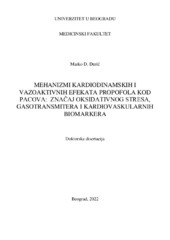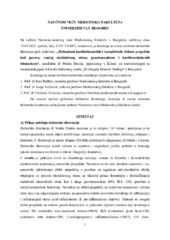Приказ основних података о дисертацији
Mehanizmi kardiodinamskih i vazoaktivnih efekata propofola kod pacova: značaj oksidativnog stresa, gasotransmitera i kardiovaskularnih biomarkera
Mechanisms of cardiodynamic and vasoactive effects of propofol in rats: the significance of oxidative stress, gasotransmitters and cardiovascular biomarkers
| dc.contributor.advisor | Stevanović, Predrag | |
| dc.contributor.other | Jakovljević, Vladimir | |
| dc.contributor.other | Palibrk, Ivan | |
| dc.contributor.other | Vučković, Sonja | |
| dc.contributor.other | Živković, Vladimir | |
| dc.creator | Đurić, Marko | |
| dc.date.accessioned | 2022-11-08T07:59:43Z | |
| dc.date.available | 2022-11-08T07:59:43Z | |
| dc.date.issued | 2022-07-01 | |
| dc.identifier.uri | https://eteze.bg.ac.rs/application/showtheses?thesesId=8778 | |
| dc.identifier.uri | https://fedorabg.bg.ac.rs/fedora/get/o:26886/bdef:Content/download | |
| dc.identifier.uri | https://plus.cobiss.net/cobiss/sr/sr/bib/78373641 | |
| dc.identifier.uri | https://nardus.mpn.gov.rs/handle/123456789/20807 | |
| dc.description.abstract | U ovoj eksperimentalnoj i translacionoj studiji ispitivani su: a) efekti akutne primene anestetika propofola na hematološke i standardne biohemijske parametre, kardiovaskularne biomarkere, i parametre oksidativnog stresa u hemolizatu, u koronarnom efluentu i u homogenatu tkiva srca, i upoređivani sa efektima akutne primene ketamina ili etomidata, b) efekti akutne primene propofola na kardiodinamske karakteristike i koronarni protok, i upoređivani sa efektima akutne primene ketamina ili etomidata, na izolovanom srcu, i c) učešće gasotransmitera (NO, H2S i CO), upotrebom specifičnih inhibitora sinteze ili produkcije, kao i odgovore na inhibiciju kalcijumskih kanala verapamilom, u efektima akutne primene propofola na kardiodinamske karakteristike, koronarni protok, parametre oksidativnog stresa u hemolizatu, u homogenatu tkiva srca i u koronarnom efluentu kod pacova. Materijal i metode: U eksperimentima su korišćeni mužjaci pacova soja Wistar albino (Ratus Norvegicus), starosti 6-8 nedelja i telesne mase oko 200- 250 g. Eksperimentalne životinje (ukupno n=84) podeljene su u 6 grupa (svaka grupa se sastojala od dve podgrupe sa 7 životinja u svakoj podgrupi: bolus injekcija anestetika propofola (1% 10 mg/ml) u dozi 100 mg/kg t.m. intraperitonealno (ip.), bolus injekcija anestetika ketamina u dozi 40 mg/kg t.m. (ip.), bolus injekcija anestetika etomidata u dozi 20 mg/kg t.m. (ip.), inhibitor enzima NO sintaze (inhibitor sinteze NO) L-NAME (Nomega-nitro-L-arginin monometil estar) u dozi 60 mg/kg t.m. (ip.) plus bolus injekcija propofola (1% 10 mg/ml) u dozi 100 mg/kg t.m. (ip.), inhibitor enzima cistationin gama liaze [(inhibitor sinteze H2S) DL-propargilglicin (DL-PAG)] u dozi 50 mg/kg t.m. (ip.) plus bolus injekcija propofola (1% 10 mg/ml) u dozi 100 mg/kg t.m. (ip.), inhibitor enzima hem oksigenaze subtip 1 (inhibitor sinteze CO) zink protoporfirin IX (ZnPPIX) u dozi 50 μmol/kg t.m. (ip.) plus bolus injekcija propofola (1% 10 mg/ml) u dozi 100 mg/kg t.m. (ip.). Podgrupe su koncipirane tako, da su se u jednoj podgrupi procenjivali kardiodinamski parametri, koronarni protok, oksidativni stres u koronarnom efluentu i odgovor na verapamil (3 μmol/l u trajanju od 5 minuta) u izolovanom srcu (ex vivo), a u drugoj podgrupi uzorkovala krv i tkivo srca anestetisanih pacova za procenu biohemijskih i hemostatskih parametara, kao i oksidativnog stresa u hemolizatu i tkivu srca. Rezultati: Ispitivanjem efekata inhibicije gasnih transmitera na hematološke i biohemijske parametre, kao i na parametre oksidativnog stresa u hemolizatu, posle primene propofola, utvrđeno je da propofol poseduje široki spektar ne-anestetskih efekata, koji su promenljivi u odnosu na status produkcije gasnih transmitera NO, H2S i CO. Ispitivanjem efekata inhibicije gasnih transmitera i influksa jona kalcijuma na kardiodinamske varijable, parametre oksidativnog stresa u koronarnom efluentu i homogenatu tkiva srca, posle primene propofola, utvrđeno je da su gasni transmiteri (NO, H2S i CO) i influks jona kalcijuma uključeni na različite načine u efekte propofola. Ispitivanjem efekata ketamina i etomidata, na biohemijske i hematološke parametre, na parametre oksidativnog stresa u hemolizatu, na kardiodinamske varijable, parametre oksidativnog stresa u koronarnom efluentu i homogenatu tkiva srca, utvrđeno je da ketamin pokazuje snažniji anti-oksidativni potencijal u poređenju sa etomidatom, a da etomidat ima povoljnije efekte u pogledu srčanih performansi. Zaključci: Rezultati istraživanja ukazuju na širi spektar ne-anestetskih efekata propofola, koji su kardioprotektivni, anti-oksidativni i citoprotektivni, u kojima učestvuju gasotransmiteri i joni kalcijuma, i koji se razlikuju od efekata drugih primenjenih anestetika ketamina i etomidata. | sr |
| dc.description.abstract | In this experimental and translational study, it was investigated: a) the effects of acute systemic anesthetic propofol administration on hematological and standard biochemical parameters, cardiovascular biomarkers, and oxidative stress parameters in hemolysate, coronary effluent and cardiac tissue homogenate, and compared with the effects of acute ketamine or etomidate administration, b) acute administration of propofol to cardiodynamic characteristics and coronary flow, and compared with the effects of acute administration of ketamine or etomidate, on the isolated heart, and c) participation of gasotransmitters (NO, H2S and CO), using specific inhibitors of synthesis or production, as well in the presence of verapamil (calcium channel blocker), all in the effects of acute administration of propofol on cardiodynamic characteristics, coronary flow, oxidative stress parameters in hemolysate, in cardiac tissue homogenate and in coronary effluent in rats. Material and methods: Male Wistar albino rats (Ratus Norvegicus), 6-8 weeks old and weighing about 200-250 g, were used in the experiments. Experimental animals (total n = 84) were divided into 6 groups (each group consisted of two subgroups with 7 animals in each subgroup: bolus injection of the anesthetic propofol (1% 10 mg/ml) at a dose of 100 mg / kg b.w. intraperitoneally) (ip.), bolus injection of anesthetic ketamine at a dose of 40 mg/kg b.w. (ip.), bolus injection of anesthetic etomidate at a dose of 20 mg/kg b.w. (ip.), inhibitor of the enzyme NO synthase (inhibitor of NO synthesis) Nomega-nitro-L-arginine monomethyl ester (L-NAME) at a dose of 60 mg/kg b.w. (ip.) plus bolus injection of propofol (1% 10 mg/ml) at a dose of 100 mg/kg b.w. (ip.), cystathionine gamma lyase (inhibitor of H2S synthesis) DL-propargylglycine (DL-PAG) at a dose of 50 mg/kg bw (ip.) plus bolus injection of propofol (1% 10 mg/ml) at a dose of 100 mg/kg b.w. (ip.), inhibitor of the enzyme heme oxygenase subtype 1 (CO synthesis inhibitor) zinc protoporphyrin IX (ZnPPIX) at a dose of 50 μmol/kg b.w. (ip.) plus bolus injection of propofol (1% 10 mg/ l) at a dose of 100 mg/kg b.w. (ip.). The subgroups are designed to are in one subgroup evaluated cardiodynamic parameters, coronary flow, oxidative stress in coronary effluent and response to verapamil (3 μmol/l for 5 minutes) in an isolated heart (ex vivo), and in the second subgroup sampled the blood and cardiac tissue of anesthetized rats for evaluation of biochemical and hemostatic parameters, as well as oxidative stress in hemolysate and cardiac tissue. Results: Investigation of the effects of gasotransmitter inhibition on hematological and biochemical parameters, as well as on oxidative stress parameters in hemolysate, after propofol administration, found that propofol has a wide range of non-anesthetic effects, which are variable in relation to gastransmitter production status NO, H2S and CO. Investigating the effects of inhibition of gasotransmitters and calcium ion influx on cardiodynamic variables, oxidative stress parameters in coronary effluent and cardiac tissue homogenate after propofol administration, it was found that gastransmitters (NO, H2S and CO) and calcium ion influx are involved in different ways in propofol effects. Investigation of the effects of ketamine and etomidate on biochemical and hematological parameters, on oxidative stress parameters in hemolysate, on cardiodynamic variables, oxidative stress parameters in coronary effluent and cardiac tissue homogenate, it was found that ketamine shows stronger antioxidant potential that etomidate which has more favorable effects in terms of cardiac performance. Conclusions: The results of the study indicate a wider range of non-anesthetic effects of propofol, which are cardioprotective, anti-oxidative and cytoprotective, involving gasotransmitters and calcium ions, and which differ from the effects of other applied anesthetics like ketamine and etomidate. | en |
| dc.format | application/pdf | |
| dc.language | sr | |
| dc.publisher | Универзитет у Београду, Медицински факултет | sr |
| dc.rights | openAccess | en |
| dc.rights.uri | https://creativecommons.org/licenses/by-nc-nd/4.0/ | |
| dc.source | Универзитет у Београду | sr |
| dc.subject | anestetici | sr |
| dc.subject | anesthetics | en |
| dc.subject | biomarkeri | sr |
| dc.subject | gasotransmiteri | sr |
| dc.subject | oksidativni stres | sr |
| dc.subject | pacov | sr |
| dc.subject | propofol | sr |
| dc.subject | biomarkers | en |
| dc.subject | gasotransmitters | en |
| dc.subject | oxidative stress | en |
| dc.subject | rat | en |
| dc.subject | propofol | en |
| dc.title | Mehanizmi kardiodinamskih i vazoaktivnih efekata propofola kod pacova: značaj oksidativnog stresa, gasotransmitera i kardiovaskularnih biomarkera | sr |
| dc.title.alternative | Mechanisms of cardiodynamic and vasoactive effects of propofol in rats: the significance of oxidative stress, gasotransmitters and cardiovascular biomarkers | en |
| dc.type | doctoralThesis | |
| dc.rights.license | BY-NC-ND | |
| dc.identifier.fulltext | http://nardus.mpn.gov.rs/bitstream/id/146836/Disertacija_12705.pdf | |
| dc.identifier.fulltext | http://nardus.mpn.gov.rs/bitstream/id/152540/Referat.pdf | |
| dc.identifier.rcub | https://hdl.handle.net/21.15107/rcub_nardus_20807 |



